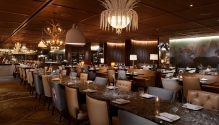Pop-Ups Offer Unique Gastronomic Adventures
Buoyed by the response and spending power of their guests, hotels and restaurants beeline to book global, Michelin, and celebrity chefs. SOH delves deep into this culinary movement that is adding much-needed revenue to the bottom line.
By Praveena Sharma
It was April last year when the executives of Culinary Culture, a food business consultant brand, and The Leela Palace, New Delhi, deliberated over what would be the right price to charge for a two-night pop-up with Massimo Bottura, the renowned Italian chef and founder of Osteria Francescana, a three Michelin star restaurant in Modena, Italy, who was looking at whipping up a culinary storm in the capital city.
The former stood firm on ₹65,000 per person, per night. While the hotel was initially hesitant to freeze the price, fearing Indian diners may not be ready to shell out that much for a night of gourmet indulgence, they were proven wrong when the pop-up sold out within minutes of it being announced.
Similarly, Conosh, a platform that curates unique experiences for diners, brought Ana Roš, chef and owner of Slovenia’s acclaimed three Michelin starred Hiša Franko to The Taj Mahal Palace Mumbai for a two-day pop-up and masterclass. Diners shelled out ₹35,000 per person, per night.
In recent years, the propensity of Indians to splurge on food that’s innovative in taste and presentation, and indulges all their other senses along with their palate, has considerably gone up.

An exotic culinary delight prepared by Chef Massimo Bottura.
India is going through a culinary renaissance
To create interesting experiences for diners, restaurants and hotels get chefs from across the world to bring their unique flavours to India. “India is going through a pop-up fixation. While once international chefs mainly came down to Mumbai and Delhi, pop-ups are now regularly being organised in other cities such as Kolkata, Bangalore, and even Goa, Chandigarh and Hyderabad,” states Raaj Sanghvi, CEO, Culinary Culture.
He believes that social media has played an important role in transforming international chefs into celebrities and creating greater awareness about them among Indian diners. Some celebrity chefs have millions of followers on Instagram and other social media platforms. This helps them promote their pop-ups on social media. Their restaurants are on the ‘must-visit’ list of globe-trotting Indians.
However, with a long wait for reservations—sometimes over six months—it is difficult for them to reserve a table at these fine-dine eateries abroad. So, when chefs from these coveted restaurants visit India, High Net-worth Indians (HNIs) do not hesitate to pay a premium for the exclusive experience.
“Once, affluent Indians were ready to spend upwards of £300 a night for a dinner in London or upwards of £500 or $500 a night in Dubai, but they held themselves back in India. I think that has changed. We are seeing so much spending power here. That is why we were confident of our price for Chef Massimo Bottura’s pop-up,” Sanghvi tells us.
Sensing the surging demand and the branding value that is derived from pop-ups, Marriott International has a vertical solely dedicated to it. In 2019, it launched the Masters of Marriott Bonvoy which has, to date, hosted top chefs such as Massimo Bottura, Marco Pierre White and Julien Royer, along with others.
“We plan exclusive ticketed experiences, master classes and opportunities for our guests to engage with global culinary luminaries. We are constantly evaluating and searching for new opportunities,” says Khushnooma Kapadia, Vice President— Marketing, South Asia, Marriott International. Trying to get the Michelin chefs to allot time is no mean task.
Kapadia says Marriott arduously works with partners such as Culinary Culture. “The journey of these initiatives spans almost six months, demanding meticulous effort in identifying chefs whose expertise seamlessly aligns with the conceptual and culinary experience we wish to bring alive. The collaboration covers in-depth discussions on the event’s theme, duration, and the specific audience we aim to captivate,” she tells us.
Before the overseas chefs land in India, they conduct several rounds of detailed discussions with the in-house culinary teams at the hotel to avoid last-minute glitches. When JW Marriott Goa flew down Chef Michele Pascarella, who was awarded the title of the Best Pizza Chef on the Planet at the World 50 Top Pizza Awards last year, the hotel’s general manager Neha Chhabra ensured that the tiniest details of the event were in place before he arrived.

Massimo Bottura, renowned Italian chef and founder of Osteria Fransescana, a three-star Michelin restaurant in Italy.

Khushnooma Kapadia, Vice President–Marketing, South Asia, Marriott International
The journey of these initiatives spans almost six months, demanding meticulous effort in identifying chefs whose expertise seamlessly aligns with the conceptual and culinary experience we wish to bring alive .
Khushnooma Kapadia
Vice President–Marketing, South Asia, Marriott International

How hotels are leveraging the pop-up trend
She and her team searched high and low to acquire the right ingredients for the award-winning pizzaiolo. “Sourcing ingredients is an art. Our teams had to reach out to different cities to ensure that we got the essential ingredients. A lot of planning and detailing went into it,” says Chhabra. Pascarella, along with Chhabra and her kitchen team crafted a dinner spread that included several courses with different kinds of pizzas including a dessert version. The meal, along with alcohol, was priced at ₹8,500 per person. In this instance too, the seats sold out almost instantly.
In January 2023 two gourmet experiences companies, Gormei, helmed by Argha Sen, and Pune-based The Hedonist, founded by Prasad Thergaonkar and Rishi Bhog, flew down Chef Alex Fargas to Mumbai’s Mag St. Kitchen. The chef-owner at La Paloma, one of Hong Kong’s most popular Spanish restaurants, believes that an excellent Spanish restaurant is hard to come by because of the kind of ingredients the cuisine requires. “You need Spanish olive oil, the quality of the ham is important, as is the rice and fresh seafood. Spanish ingredients take a bit longer to be available to everyone.”
In Mumbai, the chef changed the paella as he couldn’t get the right quality of fresh lobster. “Over time we have built a strong network of suppliers so it is a little easier, although there are challenges. I used to be a pilot and sometimes, I even had to arm-twist my friends from my pilot days to bring back some ingredients while travelling internationally. It’s a hustle but we make it happen,” says Thergaonkar.
The Park Bangalore collaborated with Ladakh’s Alchi Kitchen, helmed by Chef Nilza Wangmo, who showcased Ladakhi cuisine. “The region between Tibet and the Indian subcontinent has a diverse culinary heritage and rich history. From hearty stews and soups to delicious dumplings and aromatic teas, Ladakhi cuisine reflects the true diversity of the region and culture,” says Chef Wangmo. The hotel not only created a whole new revenue stream from pop-ups but also introduced diners to a cuisine they had never eaten before.

Ana Roš, chef and owner of Slovenia's acclaimed three-Michelin starred Hisa Francko, conducted a two-day pop-up and masterclass at the Taj Mahal Palace Mumbai.

Chef pop-ups open up new horizons
From a chef’s perspective, pop-ups in different countries open up new culinary horizons. Besides experimenting—imparting contemporary twists to traditional cuisines—it helps them soak in knowledge of different global cuisines. “I am from Italy but I live in London. I go to a lot of kitchens because I want to know more. When we go for pop-ups, we learn so much about new cuisines and the culture of the city in just a few days,” Pascarella explains. The pizza maker will be back in India this year in the midst of zipping across Europe and America for pop-ups.
Chefs often customise or adapt their fare for Indian taste buds at these pop-ups. For instance, Pascarella was requested to steer away from using anchovies (tiny forage fish) as a pizza topping.

Chef Michele Pascarella was awarded the title of Best Pizza Chef of the Planet at the Worl'd 50 Top Pizza Awards last year.

Pop-ups engender culinary exchange
Chef Daniel Humm, whose Eleven Madison Park in New York was voted as the World’s Best Restaurant in 2017, was deeply intrigued by dosa on his trip to India, in 2018. The simple breakfast from India’s southern region sent him on an obsessive journey to create a dish for his restaurant. He practised making dosas with different batters. On his return to the US, the Swiss chef offered up tomato dosas. He replaced the coconut chutney with goat cheese and green tomato relish and served the dish with tomato tea.
Sanghvi points out that almost all foreign chefs visiting Delhi make a trip to Bukhara, a restaurant at the ITC Maurya, to learn tandoor, a method in which food is cooked in a clay oven over coal, gas, or electricity. He says, “It’s a two-way culinary exchange. Indians gain by experiencing the food of celebrity chefs from abroad while the chefs gain by learning about India’s culture and cuisine.”
Sanghvi’s food consultancy firm has flown in over 60 chefs from across the world to India for pop-ups at Hyatt, Leela, ITC, Oberoi, Marriott, Taj, and others since 2017-18. The number of pop-ups has gone up from one a month initially, to two every month now.
One of the many reasons why pop-ups are a success with global chefs, he says, is their lack of presence on the ground in India. “They try and explore the Indian market on their visits here.”

Chef Nilza Wangmo of Ladakh's Alchi Kitchen.
I took home some interesting Indian cooking techniques. I feel I have been too conservative, and too narrow-minded in terms of technique. I see the incorporation of techniques from different parts of the world as the next evolution of our foo.
Chef Daniel Humm
Eleven Madison Park, New York

India gets its first Michelin-starrred restaurant
In 2023, Conosh brought Dubai’s One Michelin-starred restaurant Avatara to India for a pop-up at Conrad Pune. They followed this success with an outpost in Mumbai, the city's first fine dine vegetarian restaurant.Before this, the same team had brought down the Michelin-starrred Trèsind. It has taken a long time for a second Michelin-starred restaurant to open in India. Apart from commercial factors, unviable levies have dissuaded them from opening their outposts.
Marriott International’s Kapadia believes the sustainability of chef pop-ups will depend “on the adaptability of the culinary landscape and the sustained interest of diners in these exclusive and transient culinary events”. While a few years ago the idea of having access to a Michelin-star chef’s secret sauce in a hotel in India would seem far-fetched to many, the pop-ups have made this a reality. This burgeoning trend is not going anywhere as long as those involved with it keep pace with evolving consumer preferences, culinary innovation, and demand for unique dining experiences.

Chef Daniel Humm, Eleven Madison Park, New York.
The heritage of pop-ups
Pop-ups have existed since the time of the khansamas in India, who travelled to other kingdoms to cross-pollinate ideas and learn new techniques and traditions. They were the first idea of pop-ups. Kingdoms also exchanged khansamas. Anglo-Indian writer Bridget Kumar-White once wrote, “Khansamas made amazing dishes, guarding recipes closely while meticulously recording ingredients, techniques, even the art of plating food.” Royal families possessed a posse of khansamas who travelled with them and cooked in different destinations. Food and dining were seen as entertainment, and royal households competed on which of their khansamas would present the most innovative food.
The only thing that has changed since then is the way these collaborations happen—it could be as local as a home chef working with a restaurant for a one-time event, as is the case with a chef or restaurant pop-up or could involve a longer association with an international restaurant such as the Indian Accent pop-up in Singapore.


























